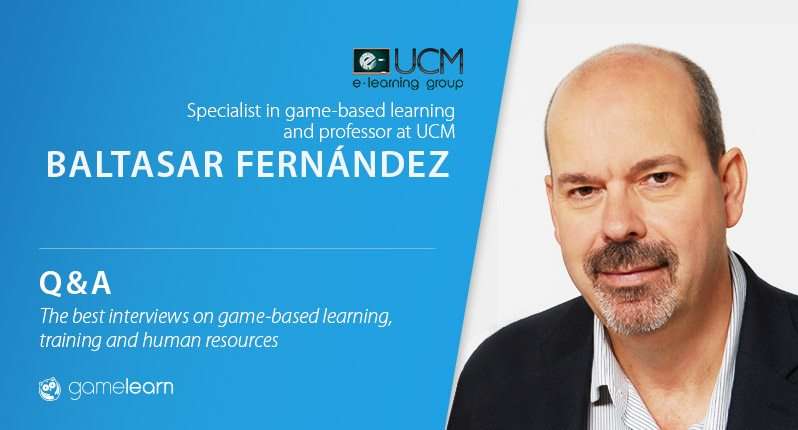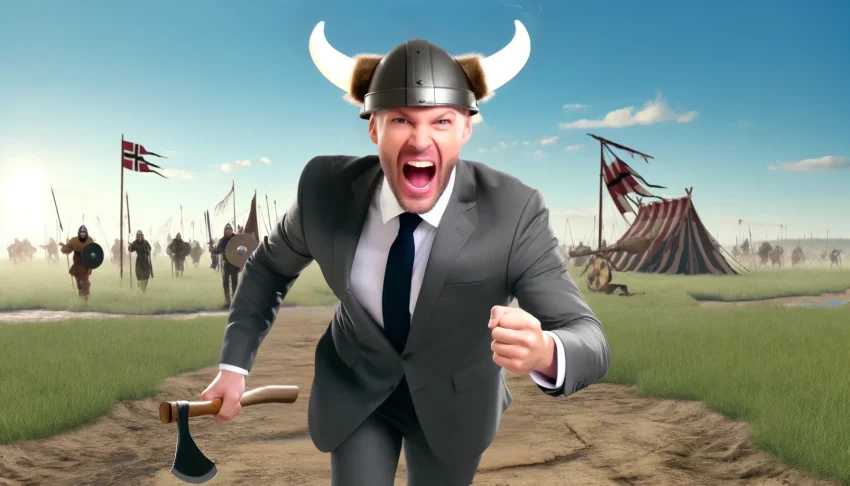“Video games show you that failure is part of learning and that you can always improve”
In the world of video games, Baltasar Fernández Manjón knows where to find the hidden screens, extra lives and shortcuts to the finish. This professor of the Complutense University of Madrid (UCM) has been studying and designing educational technologies and video games since the 1990s. In addition to leading the UCM’s e-learning group, which develops all types of software, apps and video games, Baltasar is also participating in two of Europe’s most ambitious projects on the use of video games for learning, RAGE and BEACONING, as part of the Horizon 2020 program.
We at Gamelearn were lucky enough to have the opportunity to chat with Baltasar Fernández Manjón to find out what stage game-based learning is at, how this fledgling industry is developing and the advantages of video games for learning.
– Many people still think that video games are just something teenagers do for fun. But what else can video games be used for?
The first thing we have to do is debunk a number of myths. The first one being that they are only played by teenagers; in reality, the average age of video gamers is 35. So we’re not just talking about teenagers.
Secondly, this is a huge industry. People always talk about cinema, but the video game industry generates twice as much revenue. It’s a global industry and, what’s more, an industry you can compete in without the infrastructure constraints you have with cinema.
Therefore, on the one hand, you have a huge industry and, on the other, there’s the fact that our teenagers and kids play. So why not use it for teaching? Kids who have difficulty concentrating have a longer attention span when they play a game they like; so, if they’re going to play anyway, why not try to create games where they can actually learn things?
I have an even more groundbreaking view: in a way, I see video games as the new books. Why not steer our teenagers and young people towards video games that are going to teach them cultural and social values? It’s not only about slaying monsters.
– So, what are the advantages of game-based learning?
Look, I can tell you about an experiment we’re doing today. We have developed a video game to teach young people how to respond in an emergency: it’s a first aid video game. We are training children aged between 12 and 16 in a primary and secondary school in Madrid in first aid techniques. Ideally, you should bring medical staff, a defibrillator and a medical dummy, that would be the right thing to do. But we don’t do that. Why? Because it’s very expensive.
We, in collaboration with the center for educational technologies in Aragón and Miguel Servet hospital, have developed a video game that may not be as good as having a dummy and defibrillator, but it nevertheless serves the purpose. All of a sudden, we’re able to do this in a school and train all children aged between 12 and 16; we’re talking about training 200 children in four mornings. At a very low cost. And the kids learn the basics of first aid.
The problem, of course, is that video games cost money. But once you’ve made one (this particular one was developed and paid for with public funds), it can be reused and is available to any school that wants it. In other words, it is scalable to many other schools at no additional cost.
– One of the benefits always mentioned in relation to game-based learning is motivation, the ability to engage students.
Yes, but I think we have to be clear on this point. Serious games that have a more educational focus are not as much fun as the games they normally play. But I always say that they have to be entertaining, they have to keep them motivated. And, above all, they have to be interesting. Unlike in a passive video, in a video game they have to make decisions.
What’s more, the video game is hard on them. They don’t always win. The game tells them when they’re doing it wrong. And, nevertheless, kids see it as a challenge and are prepared for it. Compared to a school where, perhaps, there is an overemphasis on avoiding negative messages, kids accept failure in a natural way and this motivates them to improve and continue learning.
Another important point is that, while in this particular video game on first aid the students play individually, very interesting competitive dynamics emerge in the classroom. All of a sudden, someone says: “Great. I’ve saved him! I got an 8!”. And somebody else says: “Mine’s red. I got a 2!”. And suddenly, there’s a personal motivation to do better. And you’re not competing against anybody. You’re competing against yourself. You want to improve. You want to do it better using your own resources.
So, what do video games teach you? They teach you resilience. They teach you that failure is part of learning, that you can improve yourself, that if you make an effort, you can do it better. What more can you ask for?
– Video games are often associated with antisocial or violent behavior. However, can video games also promote solidarity and prosocial conduct?
Yes. In fact, one of the video games we’re developing at the moment is a game to tackle cyberbullying (bullying using electronic technology), which is a very serious problem among young people. They are making abnormal use of technology: they don’t realize that what they say in WhatsApp or social media, even if intended as a joke, stays there. Or that a spoken joke, where there is context, is not the same when it is taken out of that context and put in social media, where it could be seen as an affront or very negative, which was probably not the intention.
So we are making a game about cyberbullying so that kids can understand the implications of their actions, the consequences of their digital footprint… and it’s not only about learning; we also want to get them to empathize. We want them to feel what the victim feels, what the bully feels. And learn from it.
This year we are also participating in initiatives such as Hack For Good, where technologists, designers and social motivators come together for two days and work together to try to come up with solutions to the social problems raised by NGOs, patient associations and public and educational institutions.
We are also making a video game about active aging, which is part-funded by the Telefónica-Complutense Chair on Serious Games. This is a subject that has barely been touched upon, but very interesting initiatives are being undertaken worldwide to see how video games can be used with older people. For example, we have exergaming, where the aim is to get people to do exercise at home instead of having to go to the health center.
– You started working on these issues when they were still in their infancy, almost an eccentricity. In recent years, game-based learning has seen dramatic growth. How do you see this transformation in the industry?
Well, I believe the market is not yet mature. However, there is a growing interest and, above all, more funding. We are entering the terrain of IT standards; investment is beginning to trickle in. The effectiveness and productivity of game-based learning has been demonstrated, and we could say that it just needs a small push for the market to become that little bit more mature.
– What sectors are at the forefront of game-based learning? Where is it most used?
The three main sectors are the ones that are spending the most. The first is the military sector, where, in some cases, it could easily be applied in a civilian context. For instance, there are video games that aim to avoid prejudices when judging people on the basis of their race or religion. This is very important in military intelligence, and to be able to properly assess the information you receive.
The second is the field of medicine. We have worked with Massachusetts General Hospital and Harvard University. Using video games, we can reuse the same training process that Harvard uses for cytopathology (the study and diagnosis of diseases on the cellular level), and deploy it to developing countries using tablets that cost 50 Euros. This is particularly important in cases where there is a shortage of medical staff or when doctors have to be evacuated due to an emergency (such as the case of Ebola).
And the third is the field of business. Companies are working on productivity using video games, as evidenced by the case of Gamelearn.
These are the three sectors where game-based learning is most used. Why? Basically because it’s where most of the money is.
At the moment, game-based learning is also being used in education. However, the main problem in Europe and, above all, in Spain is that the market is highly fragmented. Games require a certain amount of up-front investment and very often the minimum investment cannot be secured to produce games of a sufficient quality to make them effective for use in the classroom. But some interesting cases are emerging.
– You mentioned the importance of video games for corporate training. How can game-based learning help the world of business?
There is a lot of interest in gamification right now. All companies are very interested in introducing game strategies into processes that are not game-related. I think this is the first step.
Many others are creating games to resolve problems that are very difficult to solve in other ways. For example: how can you solve communication problems in a multicultural company? A lot of things are hard to understand until you experience them, but you don’t have that opportunity, and video games can put you in situations where you have to make an effective decision in a short space of time.
– In the beginning, some people did not believe in video games as a tool for learning. In recent years, however, the question is no longer whether to use them, but ‘how’ to use them. What, in your opinion, are the key elements of a serious game?
If I had the answer, I’d probably be rich instead of lecturing at a university (laughs). I believe the secret is to take a serious scientific approach. What we do is we deploy the games in real environments and then evaluate them. Basically, the way to make a good game is through trial and error. You make a game, you test it, you formally assess it and you see what works and what doesn’t. You do this interactively and in the end you have a good game. We know no other way of doing it.
Another important element is the story. We make games that basically tell a story. Our tradition, first oral and then written, is that we are very good at remembering stories and very bad at remembering data. We always try to make the story important and interesting. In a video game, if the supporting narrative is good, the game will work. You will have to make decisions, but you will remember it and you will learn from it.
And, of course, the game should be, I wouldn’t exactly say fun (because this is a process that occurs in your mind), but interesting. There’s nothing worse than a boring game. If a game is boring and it cost a lot of money, it’s falling into the pitfall of the worst educational practice. The game has to be entertaining, it has to motivate players.
– To finish, we’re going to put you in a tight spot. What are your three favorite serious games?
That’s a difficult question.
What I do with some of these educational games is try them out on my own children or students. For example, a game I like a lot is Treefrog Treasure, which is about a frog that teaches fractions. It’s a world where you have to break through chains and, to do this, you have to know your fractions; you have to know what a percentage is. And the funny thing is, I’ve given it to my daughter, who hasn’t done fractions yet, and she loves it. And, as a result, she’s grasped the informal concept of fractions. So it does work.
And to teach programming, for instance, there’s a game called CodeCombat, where you have to control the avatars’ actions by typing lines of code. I use this with my Masters students. I have 40 hours to teach programming to students who have never programmed before. And this motivates them.
And another one that’s midway between a serious game and gamification is Duolingo. We have a real problem about how to teach the kids vocabulary in school. But you can do this with Duolingo. It’s not exactly a game, but the kids sometimes think it is. We are trying to learn from these games too and reuse things. I’m using it to improve my Portuguese. What’s more, the game has a feature that allows it to be used in class, where learning analysis techniques are used to tell you what the students are doing and their progress. This is one of the research topics we are working on at the moment.





